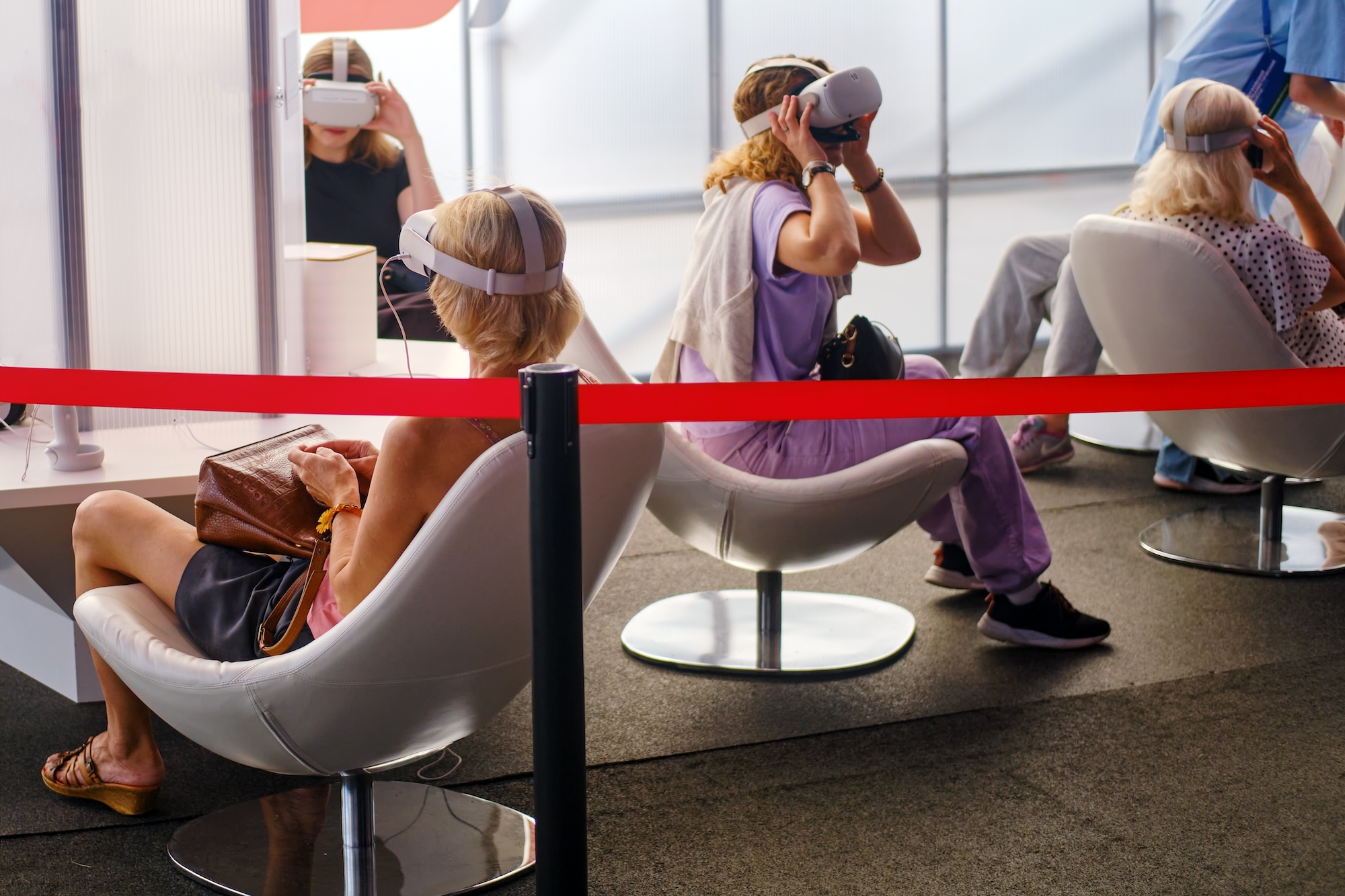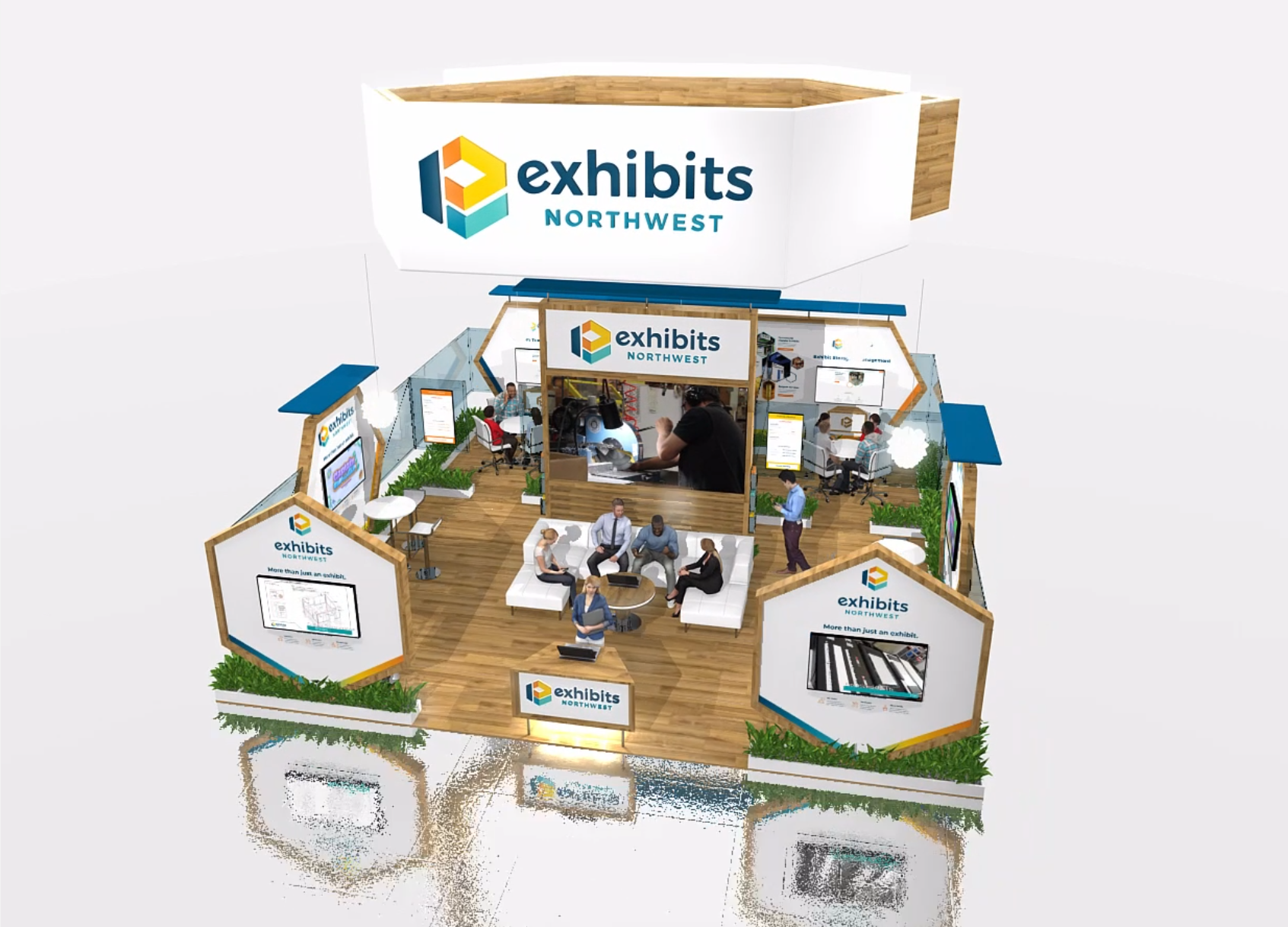Technology surrounds us in nearly everything we do. As a result, we forget how quickly it evolves. At trade shows, for example, just 20 years ago monitors were small, heavy, and bulky. Backlit graphics were for A-list exhibitors with six-figure budgets. Speedy internet, large format fabric graphics, and web-based interactive games were still several years away.
It’s OK to reminisce about the “good old days,” but no one misses Velcro-attached graphics, folding fabric panel systems, or clunky, yet expensive, lead retrieval systems. Trade show technology has made it easier to demonstrate products and services, create immersive experiences on the show floor, and track clients throughout the buying process. And we’ve only begun to tap into the potential of artificial intelligence (AI), augmented reality (AR), and LED video tiles.
Let’s explore some of the trade show technology options available to exhibitors both big and small.
Trade Show Technology: Transforming Exhibits into Experiences
Not so long ago, the standard definition of a trade show or trade fair was an event specifically designed to connect businesses within a particular industry.
It was an opportunity to:
- Showcase Products and Services: This is a key element of trade shows. Businesses set up booths to display their latest offerings and provide demonstrations to potential customers and partners.
- Network and Build Relationships: Trade shows offer valuable opportunities to connect with other businesses in the industry. This can lead to new partnerships, collaborations, or simply a chance to learn from each other.
- Learn about Industry Trends: Trade shows are a great way to see what’s new and innovative in your industry. Companies often use these events to launch new products or announce major developments.
That’s still true, but there’s been a dramatic shift to creating memorable experiences for attendees. Experiential trade show marketing (vs. traditional trade show marketing) is a strategy that transforms a trade show booth into an engaging experience. Instead of just displaying products or handing out brochures, exhibitors are encouraged to create memorable interactions that leave a positive impression of their brand.
What does that mean, specifically? Exhibitors should:
- Focus on experiences, not just promotions: It’s about creating something interactive and engaging, rather than a one-way sales pitch.
- Emotional connections: The goal is to evoke positive emotions and build a connection with potential customers through the experience.
- Brand storytelling: The experience becomes a way to showcase your brand’s values, mission, and what makes you unique.
- Stand out from the crowd: In a sea of traditional booths, an experiential approach can grab attention and make your brand more memorable.
Overall, experiential trade show marketing is about going beyond just exhibiting your product or service. It’s about creating a lasting impression and building relationships with potential customers through engaging experiences.

Driving Engagement & Interaction with 9 Trade Show Technologies
Trade shows and events are a great place to see the latest technology in action. Here are some of the biggest trends in 2024:
Hybrid Events: The pandemic forced many trade shows to go virtual, and this trend is likely to continue in a hybrid format. This means that events will have both in-person and virtual components, allowing people to participate from anywhere in the world.
Artificial Intelligence (AI): AI can be used to personalize the attendees experience at trade shows. For example, AI can be used to recommend exhibitors to visit based on their interests or to create chatbots that can answer attendees’ questions.
Augmented Reality (AR) and Virtual Reality (VR): AR and VR can be used to create immersive experiences for attendees. For example, AR can be used to overlay information on top of the real world, such as product information or directions to a booth. VR can be used to transport attendees to a different location, such as a virtual factory tour.
Advanced Analytics: Trade shows can use advanced analytics to track attendee behavior and measure the success of their events. This data can then be used to improve future events.
5G Connectivity: 5G connectivity will provide faster and more reliable internet access at trade shows. This will allow for more immersive experiences, such as live streaming of events in high definition. The Internet of Things (IoT) can be used to connect devices at trade shows, such as sensors that track attendee traffic or beacons that send targeted messages to attendees’ smartphones.
Contactless Technology: In the wake of the pandemic, there is a continued focus on contactless technology and health safety at trade shows. This includes things like contactless badge scanning, hand sanitizer stations, and plexiglass barriers at booths.
Mobile Apps and Event Management Platforms: Mobile apps can provide attendees with information about the event, such as the schedule of events, a list of exhibitors, and a map of the venue. Event management platforms can be used to manage all aspects of the event, from registration to lead generation.
Interactive Exhibits and Gamification: Interactive exhibits and gamification can be used to make trade shows more engaging for attendees. For example, exhibitors can use interactive games to teach attendees about their products or services.
Advanced Lead Capture: Trade shows can use advanced lead capture and management tools to capture leads from attendees and track their interactions with exhibitors. This data can then be used to follow up with leads after the event.
Virtual Trade Show Software: Expanding Reach & Accessibility
The COVID pandemic thrust virtual trade shows and events into the forefront. Frankly, no one was ready, least of all software developers, event providers, and exhibit houses. It was a Trial by Fire and everyone suffered first, second, or third-degree burns. We’ve all had a chance to heal over the past few years, so it’s time to revisit the best models and practices for virtual trade show software.
There isn’t a single “best” model for virtual trade show software, as the ideal choice depends on your specific needs and priorities. Here’s a breakdown of some common models to consider:
Features and Functionality:
- Comprehensiveness: Some platforms offer a wide range of features, including booth design tools, live streaming capabilities, webinar integration, lead capture forms, and data analytics. These platforms are suitable for complex events with a lot of moving parts.
- Focus on Engagement: Other platforms prioritize attendee engagement with features like interactive product demos, gamification elements, and chat functionality. These are ideal for creating a dynamic and memorable experience for attendees.
- Ease of Use: Some platforms are designed to be user-friendly and easy to set up, even for those with no technical experience. This can be important if you have limited resources or time.
Cost and Scalability:
- Subscription Model: Many platforms offer a subscription-based pricing model, with different tiers based on features and the number of attendees you expect. This can be a good option if you plan to host virtual trade shows on a regular basis.
- Pay-Per-Use: Some platforms offer a pay-per-use model, where you only pay for the features and functionality you need for a specific event. This can be a good option for smaller events or those with a limited budget.
- Enterprise-Level Solutions: For very large or complex events, there may be enterprise-level solutions available that offer a high degree of customization and support. These typically come with a higher price tag.
Additional Considerations:
- 3D Virtual Environments: Some platforms offer 3D virtual environments that allow attendees to navigate a virtual exhibition hall and interact with booths in a more immersive way. This can be a great way to create a more realistic and engaging experience.
- Integrations: Consider how well the platform integrates with your existing marketing and CRM tools. This can streamline your workflow and make it easier to manage leads and data.
By carefully considering your needs and priorities, you can choose the virtual trade show software model that is the best fit for your next event.

Implementing Trade Show Technologies: Best Practices
Here are some best practices to consider when incorporating technology into your trade show booth:
Pre-show Planning:
- Align Your Goals: Before diving into tech options, determine what you want to achieve at the trade show. Is it lead generation, brand awareness, product demonstrations, or something else? This will guide your choice of trade show technology.
- Target Your Audience: Consider who you’re trying to attract and what would resonate with them. Tech should enhance the experience, not alienate potential customers who might prefer a more traditional approach.
Choose the Right Technology:
- Interactive Elements: People remember experiences they participate in. Use touchscreens, games, quizzes, or VR/AR experiences to grab attention and educate attendees about your product or service.
- Digital Signage: High-resolution displays can showcase dynamic content, videos, presentations, and product features in a visually compelling way.
- Lead Capture and CRM Integration: Utilize tablets or digital forms to streamline lead capture. Integrate your system with your CRM for efficient follow-up after the show.
- Social Media Integration: Encourage social media engagement with a branded hashtag, contests, or photo booths. This can expand your reach and generate buzz.
Optimize the Attendee Experience:
- Seamless User Experience: Ensure your technology is user-friendly and functions smoothly. Offer technical support on hand in case of glitches.
- Data Collection: While tech can help gather data on attendees, be transparent about data collection practices. Focus on collecting information that will be valuable for follow-up and engagement, not just capturing random data.
- Staff Training: Equip your team with the knowledge to use the technology effectively and answer attendee questions. Their enthusiasm and product expertise are still key to a successful show.
Additional Tips:
- Consider Accessibility: Ensure your technology is accessible to all attendees, including those with disabilities.
- Internet Connectivity: Have a reliable backup plan in case of Wi-Fi issues.
- Measure and Analyze Results: Track engagement metrics and lead generation to assess the effectiveness of your tech-driven strategies. Use this data to improve your approach for future shows.
By following these best practices, you can leverage technology to create a more engaging and impactful trade show experience that helps you achieve your business goals.
Discover the Latest Trade Show Technology with Exhibits NW!
The COVID pandemic reset everyone’s expectations about trade show marketing. Successful exhibitors are now hyper-focused on creating memorable experiences for attendees that build brand awareness. Fortunately, exhibitors now have a variety of technologies available to attract attendees, tell their story, and track their results. When you work with Exhibits Northwest, you’ll have a team dedicated to your trade show success whether that’s designing the perfect customized trade show exhibit, developing a strategic marketing plan, or identifying the ideal trade show technologies to achieve your goals.
At Exhibits Northwest, we’ve been designing and fabricating exhibits for more than 20 years. More importantly, we’ve been partnering with companies to elevate their trade show marketing campaigns and guiding them through the hidden landmines of trade shows.
